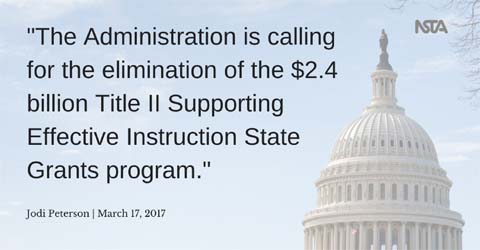Legislative Update
Trump Releases “Skinny Budget” for FY2018
By Jodi Peterson
Posted on 2017-03-17

Administration’s Proposal Funds School Choice, Eliminates ESSA Title II and Afterschool Programs
President Trump released his “skinny budget” on Thursday, March 16 and as expected, the budget increases defense and security but cuts funding for key education programs.
The 2018 Budget proposes $59 billion for the Department of Education, a $9.2 billion cut to the Education Department’s $68 billion budget, which would cut agency spending by 13 percent below the 2017 CR level.
Funding for the two largest education programs—Title I (low income) and IDEA (special education)—was not cut. Trump’s plan seeks funding to expand choice options in public and private schools; he is proposing a $168 million increase for Charter Schools Program grants and a new $250 million private school choice program.
It would also increase Title I funds by $1 billion, with the funding available for “encouraging districts to adopt a system of student-based budgeting and open enrollment that enables federal, state and local funding to follow the student to the public school of his or her choice.” It is unclear what the intent of the funding would be, language in ESSA would allow 50 school districts to try out weighted student funding formulas which would consolidate federal, state, and local funding into one pot that would be allocated based on students’ needs. This suggests the creation of Title I portability programs, an idea/program which has been soundly rejected by Congress in previous years.
In the budget proposal, the Administration calls for the elimination of the $2.4 billion Supporting Effective Instruction State Grants program, which is Title II under ESSA (and was Title II under No Child Left Behind). Title II funds are used by schools and districts to improve teacher and principal quality and are primarily used to support teacher professional development. Read NSTA’s reaction to the budget here.
The President also calls for eliminating the $1.2 billion 21st Century Community Learning Centers afterschool program. During a press conference on the budget, Office of Management and Budget Director Mick Mulvaney said “there’s no demonstrable evidence” that afterschool programs help students. The Afterschool Alliance reaction is here.
There is no specific mention of funding in this “skinny budget” for programs under Title IVA Student Support and Academic Enrichment Grants program. The fate of this program is unclear since a larger budget proposal with more detail is expected to be released in early May.
The budget also proposes major reductions in funding for NIH, climate science, and other science-related programs across multiple agencies. Read more on the budget for science here.
In a statement announcing the budget, Secretary DeVos said, ”Today’s Budget Blueprint keeps with President Trump’s promise to focus the U.S. Department of Education on its mission to serve students. The budget places power in the hands of parents and families to choose schools that are best for their children by investing an additional $1.4 billion in school choice programs.”
It is important to remember that this budget proposal is just that and that Congress will make the final decision on how these programs are funded (or not).
Read the Washington Post overview of the entire budget proposal.
Secretary DeVos Issues Revised Template for State ESSA Plans
Secretary DeVos has issued a consolidated state plan template for state education leaders that lays out the information that is “absolutely necessary” for their ESSA plans.
As reported in the March 10th issue of the NSTA Legislative Update, the Senate and House have both overturned accountability regulations finalized last fall governing how school performance is judged under the new law. The accountability regulations were intended to direct the work of state stakeholders creating new plans required under ESSA to track low income students and intervene in high risk schools.
Democrats claim that the accountability rules were in place to ensure that states weigh students’ test scores and graduation rates heavily when they calculate which schools are succeeding and which are failing. Republicans said the accountability rules were an overreach, and that states should follow what was outlined in the ESSA statute.
Most states are working on their ESSA plans and must submit them either in April or September to meet federal deadlines (the April date was extended to May).
To view where your state is with their ESSA plan activities, go to ASCD’s ESSA State Implementation Map. Learn more about how you can ensure STEM is part of ESSA at www.successwithstem.org. To read more about the Secretary’s revised template go here.
STEM education Focus of Senate Appropriations Hearing
Finally, last week four witnesses—including NSTA member and NSELA Executive Director Larry Plank—testified before the Senate Labor HHS and Education Appropriations Subcommittee about the need for continued investments in STEM education. Click here for highlights from the STEM Education Coalition and see Planks testimony (at 42 mins) here.
Stay tuned, and watch for more updates in future issues of NSTA Express.
Jodi Peterson is the Assistant Executive Director of Communication, Legislative & Public Affairs for the National Science Teachers Association (NSTA) and Chair of the STEM Education Coalition. Reach her via e-mail at jpeterson@nsta.org or via Twitter at @stemedadvocate.
The mission of NSTA is to promote excellence and innovation in science teaching and learning for all.
Follow NSTA
Disclaimer: The views expressed in this blog post are those of the author(s) and do not necessarily reflect the official position of the National Science Teaching Association (NSTA).


